The 10 best No-Code App Builders in 2025
Written by GoodBarber Team on

Overview: which app builder is best for your needs ?
- GoodBarber : best for content / eCommerce mobile apps and App resellers (great design, CMS & monetization support)
- Bubble : best for general no-code web apps / Low-Code complex logic (powerful workflows & plugins).
- Adalo : best for fast mobile prototypes / simple native apps (drag-and-drop, native publishing options, generous free/prototype options).
- OutSystem : best for developer handoff / Enterprise scalability
- Glide : best for spreadsheet-to-app / internal tools (fast, data-driven PWAs).
GoodBarber stands out as the top choice for most users, especially eCommerce, content creators, and app resellers, thanks to its Design excellence, features extensions and white-label options. For rapid MVPs, Adalo and Thunkable offer quick setup, while OutSystems and AppGyver cater to enterprise needs. Draftbit and Bubble suit developers needing code flexibility.
Top app builders comparison: introduction
The best 10 App Builders
- GoodBarber: The best choice: the most versatile for eCommerce, content creators, and app resellers
- Adalo: for small businesses, to quickly launch a functional apps
- Thunkable: for beginners, to create an app with an AI assistant.
- AppGyver (now SAP Build Apps): to build enterprise-grade apps to integrate with other SAP platforms
- Bubble: building complex web applications (marketplaces, SaaS, internal tools)
- Bravo Studio: to convert Figma or Adobe XD designs into native mobile apps
- Draftbit: for experts and developers who want to master their source code
- Glide: for internal tools, dashboards, focusing on data-driven solutions
- Appy Pie: for beginners with generic needs
- OutSystems: for enterprise-grade, critical apps with top-tier security and scalability
No-Code vs. Low-Code: Quick Breakdown
- No-Code: Build fully functional apps with zero coding. Ideal for business users and citizen developers. Focuses on speed and simplicity with visual drag-and-drop interfaces and pre-built components.
- Low-Code: Combines visual tools with optional custom code. Favored by professional developers needing more control and customization for complex, enterprise-grade solutions.
| Characteristic | No-Code | Low-Code |
| Coding Required | None | Minimal/Optional |
| Primary User | Business users, citizen developers | Professional developers, technical users |
| Customization | Template-driven | Flexible, extensible with code |
| Complexity | SimCharaple, departmental apps | Complex, business-critical solutions |
| Code Export | Rarely available | Often available |
Top 10 app builders benchmark: the 17 criteria analysis
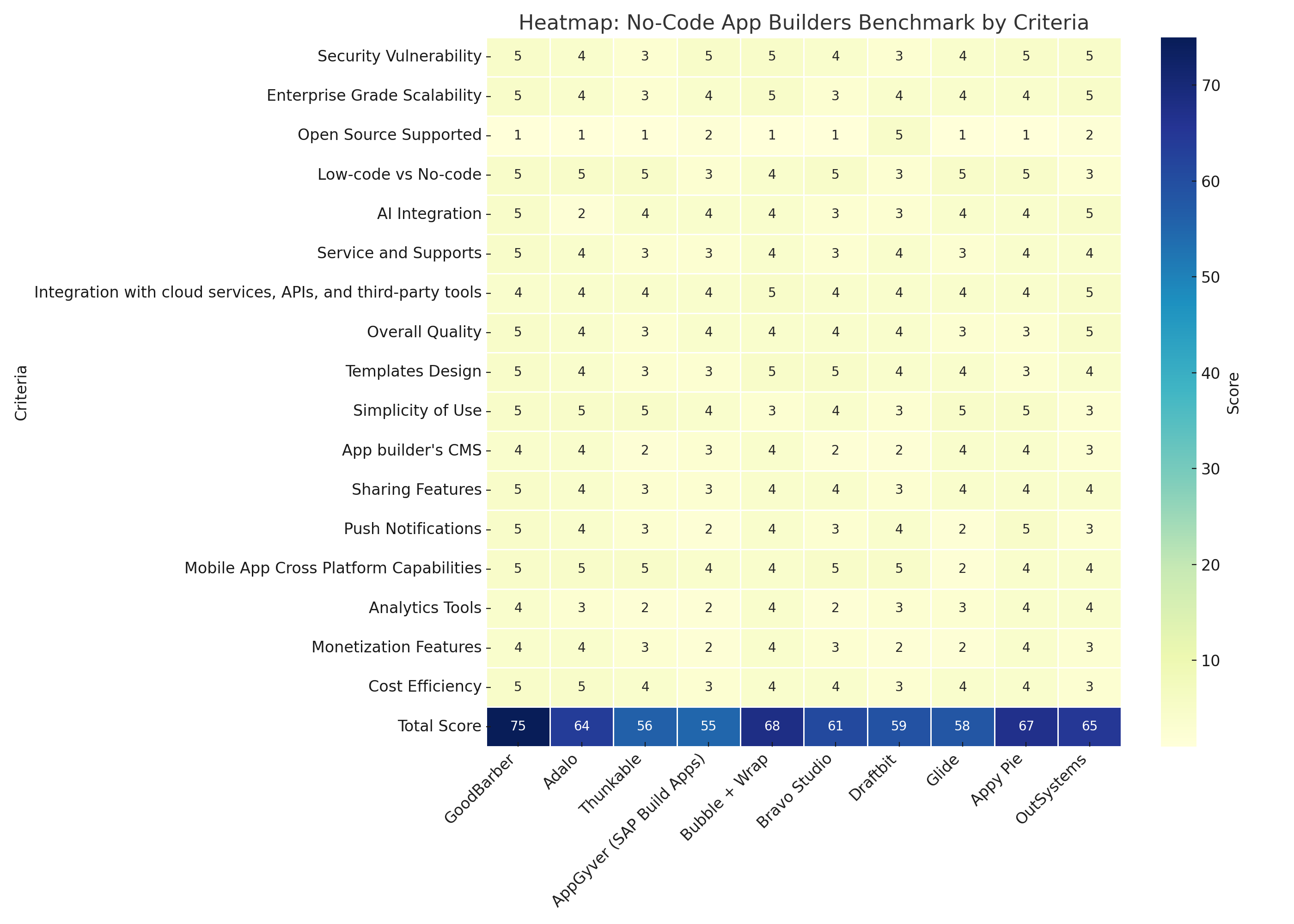
⦁ Security vulnerability: enterprise-grade security (e.g., GDPR compliance) to address data vulnerability concerns
⦁ Enterprise grade scalability
⦁ Open source supported
⦁ Low-code vs No-code
⦁ Ai integration: AI-driven automation for UI design, logic, and data integration
⦁ Service and supports: 24/7 support, community forums, and training for user adoption
⦁ Integration with cloud services, APIs, and third-party tools
⦁ Overall Quality
⦁ Templates Design
⦁ Simplicity of use
⦁ App builder's CMS
⦁ Sharing features
⦁ Push Notifications
⦁ Mobile app cross platform capabilities
⦁ Analytics Tools
⦁ Monetization features
⦁ Cost efficiency
GoodBarber
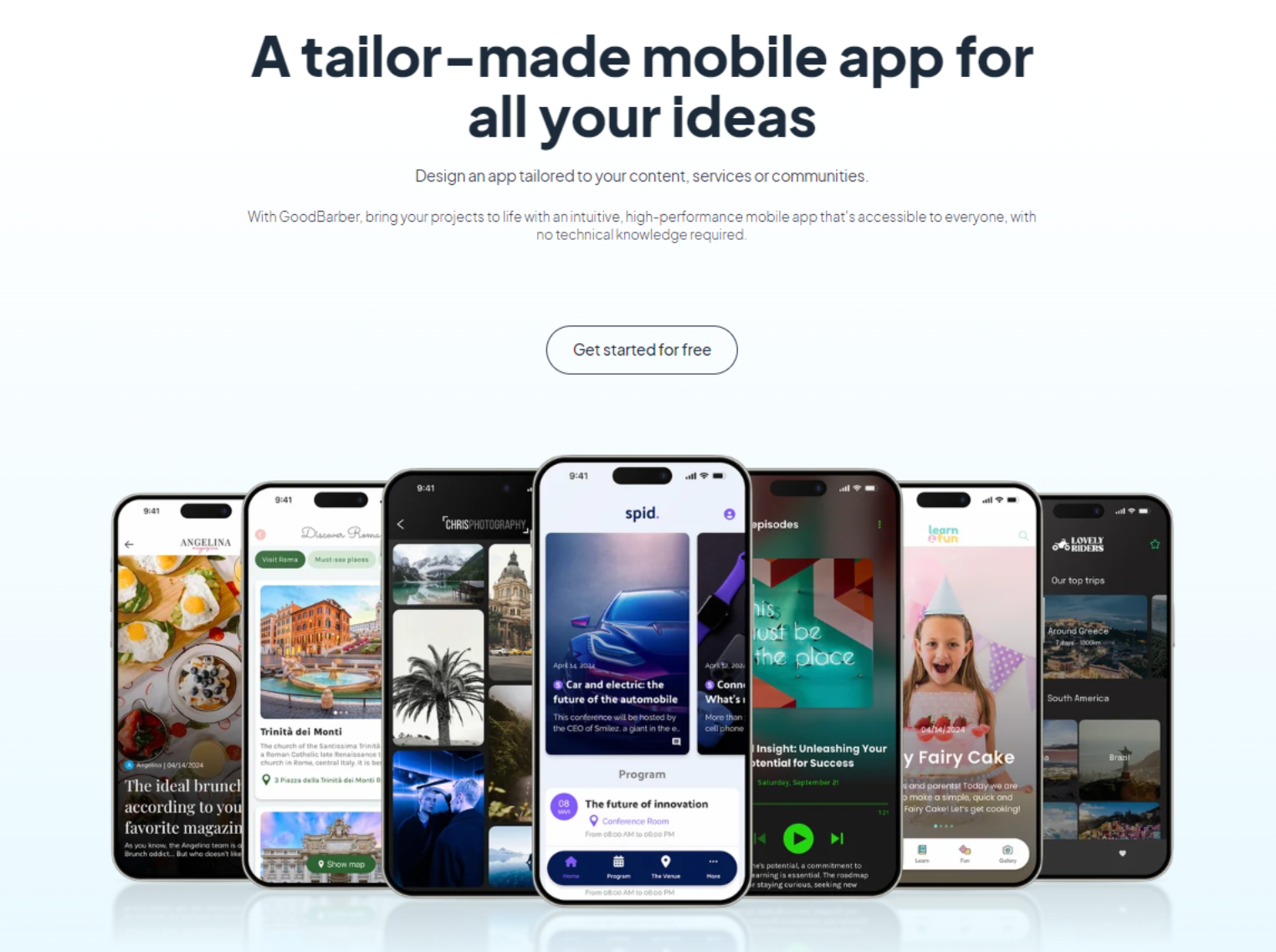
Resume: GoodBarber is a well-established no-code app builder, trusted since 2011, renowned for its focus on creating high-quality native iOS and Android applications, as well as Progressive Web Apps (PWAs). It is particularly strong for e-commerce and content-driven applications, offering an intuitive, AI-enhanced interface and a vast array of pre-built features and templates.
GoodBarber assists users to create iOS, Android and PWA apps without coding. Its app builder is easy to use and intuitive. It's a DIY tool for novice users with no programming skills that gives you access to all the features you need to create dynamic mobile apps without difficulty, using a cloud-based drag and drop editor within a WYSIWYG visual interface that eliminates the complexity of coding.
Its app making software allows you to add products, forms, widgets, Ads and your branding to your app that will be available on both iOS and Android app stores and usable from desktop, smartphone and tablet.
It also enables to complement your apps with best third-party tools to simplify the workflow, automate tasks saving precious time.
Finally, GoodBarber app builder is the best solution for anyone who wants to create professional apps with the best design [🔗], quickly and securely: everyone can use it! [🔗]
GoodBarber's interface is characterized by its intuitive, AI-enhanced design and a drag-and-drop WYSIWYG editor, allowing users to visually build apps. The dashboard provides a centralized view for managing content, products, orders, users, and statistics, with real-time previews across devices like smartphones, tablets, and desktops.
Analysis by Criteria:
- Security: Enterprise-grade, GDPR compliant, acting as a data processor.
- Scalability: Cloud-based, supports over a million users, 10GB storage per app.
- Open Source: Not open source, but offers GitHub code examples for custom HTML/JS/CSS sections.
- Low-code vs No-code: Pure no-code with a real-time WYSIWYG drag-and-drop editor.
- AI Integration: AI Assistant for content/SEO, ChatGPT for chatbots, and "Genius Palette" for design.
- Support: "Awesome Support Team" responds within 24 hours in 5 languages, 15 hours daily. Offers App Store publication assistance, tutorials, and a free Academy.
- Integrations: 190+ extensions, no-code integrations with Zapier/Make, APIs for custom workflows, and custom code sections.
- Quality: "Unmatched design quality" and "exceptional performance," trusted by experts.
- Templates: "Stunning pre-built app templates" that are 100% customizable with a "Design System" for consistency.
- Simplicity: Intuitive, AI-enhanced drag-and-drop interface for quick app creation.
- CMS: Powerful, built-in mCMS for managing articles, videos, photos, and events, with external content integration.
- Sharing: In-app share icon for native sharing to social apps (Facebook, X/Twitter, WhatsApp, SMS).
- Push Notifications: Full support for customizable, segmented notifications, including Geofencing and iBeacons.
- Cross-Platform: Creates native iOS/Android apps (Swift/Kotlin) and PWAs from a single interface.
- Analytics: Built-in analytics in the back office, plus integration with Google Analytics and Flurry.
- Monetization: Advanced e-commerce tools, in-app advertising (100% revenue to owner), and subscriptions.
- Cost Efficiency: Cost-effective, plans from $30/month, 30-day free trial. No commission on sales.
- Exceptional design quality and user experience for native apps and PWAs.
- Robust e-commerce and content management with strong monetization.
- Comprehensive AI integration for design, content, and support.
- Dedicated app store submission assistance.
- Not open-source, limiting full code access.
- Support is not 24/7.
To date, over 30,000 apps have been published through GoodBarber, and the number continues to grow, making GoodBarber an authority in the app builder industry. The platform is built in France but has expanded its roots in Portugal and the United States of America.
Moreover, GoodBarber has been reported as an highly trusted No-Code platform by many prestigious product reviews out there.
Adalo
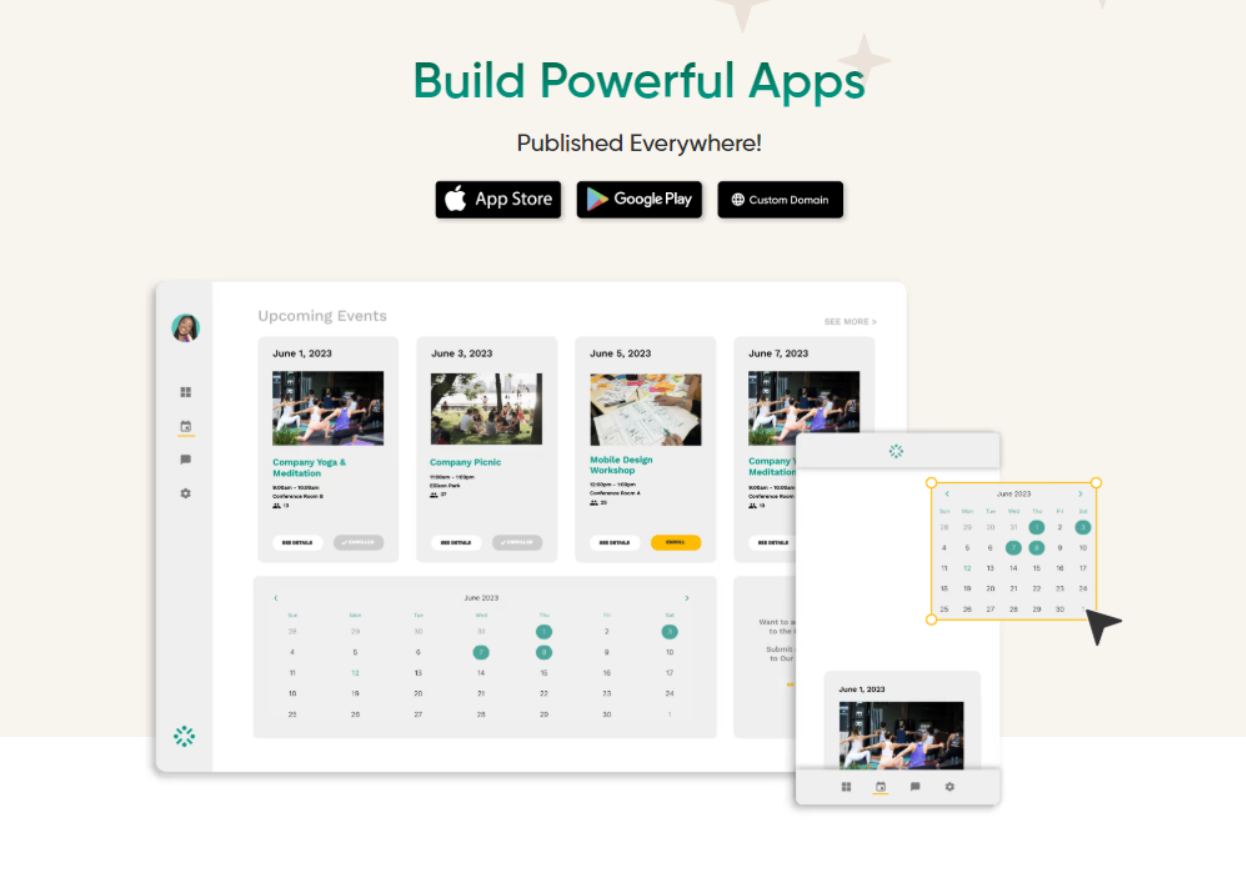
Resume: Adalo is a no-code platform that empowers users to build mobile and web applications with a drag-and-drop interface. It is particularly well-suited for entrepreneurs, startups, and small businesses looking to quickly launch functional applications with integrated databases, user authentication, and direct publishing to app stores.
Adalo is a leading no-code platform for building mobile and web apps with a drag-and-drop interface. It suits entrepreneurs and small businesses for quickly launching functional apps with integrated databases and direct app store publishing.
Analysis by Criteria:
- Security: GDPR compliant (as Data Processor), SOC 2, enterprise authentication.
- Scalability: Handles over 20 million daily requests, unlimited app actions on all plans, external database support.
- Open Source: Not open source; code export is on the roadmap.
- Low-code vs No-code: Pure no-code, designed for users with no programming skills.
- AI Integration: Relies on integrations (e.g., Zapier AI, Beam AI) for AI-powered tasks.
- Support: Help documentation, community forum, App Academy, 24/7 Live Chat for enterprise.
- Integrations: Built-in relational database, Zapier/Make, Stripe, IAPHUB, and custom API.
- Quality: "Mature, reliable platform" with an intuitive visual interface.
- Templates: Pre-built components and feature templates for rapid development.
- Simplicity: "Stupidity simple" drag-and-drop interface, intuitive for non-technical users.
- CMS: Built-in relational database for data storage and management.
- Sharing: Preview and share apps via link for feedback, team collaboration.
- Push Notifications: Supports real-time, automatically triggered push notifications.
- Cross-Platform: Build once, publish to native iOS/Android, PWAs, and responsive web apps.
- Analytics: In-app analytics tab (user location, DAU), Google Analytics integration.
- Monetization: Stripe and IAPHUB integration for in-app purchases and subscriptions.
- Cost Efficiency: Cost-effective, significantly reduces development costs, free plan available.
- Ease of use for non-technical founders.
- Strong native mobile and web app publishing.
- Robust built-in database and extensive third-party integrations.
- Predictable pricing with unlimited app actions on paid plans.
- Relies on integrations for advanced AI features.
- No code export (yet), leading to potential vendor lock-in.
Thunkable

Analysis by Criteria:
- Security: GDPR/CCPA compliant via Termly integration.
- Scalability: Suitable for moderate use; scales with external backends like Xano.
- Open Source: Not open source; no raw source code export.
- Low-code vs No-code: Pure no-code, builds apps "without writing a single line of code."
- AI Integration: AI-powered app generation from prompts, AI Chatbot Helper, Style AI, AI Debugger, AI text/image generation.
- Support: Creator Success team, Academy, community, instructional videos, direct chat for paid plans.
- Integrations: Connects to Airtable, Firebase, Google Sheets, Xano, any REST API, RevenueCat, Figma.
- Quality: Flexible and robust for functional mobile apps, but some performance issues with complexity.
- Templates: Wide selection of pre-built components; AI generates screens/layouts.
- Simplicity: Highly beginner-friendly with intuitive drag-and-drop and block-based logic.
- CMS: No built-in CMS; relies on external databases for content.
- Sharing: Share editable/read-only project copies, workspace collaboration.
- Push Notifications: Supports native push notifications for engagement.
- Cross-Platform: Builds native iOS/Android and web apps from a single codebase.
- Analytics: No specific native tools; relies on external integrations.
- Monetization: Integrates with RevenueCat for in-app purchases/subscriptions, and AdMob ads for paid plans.
- Cost Efficiency: Accessible, plans from $19/month, free tier available.
- Highly intuitive and beginner-friendly.
- Strong AI integration for rapid app generation.
- Excellent cross-platform native app capabilities.
- Extensive third-party integrations.
- No source code export.
- Limited native analytics.
- Performance may be limited for very complex apps.
AppGyver (now SAP Build Apps)
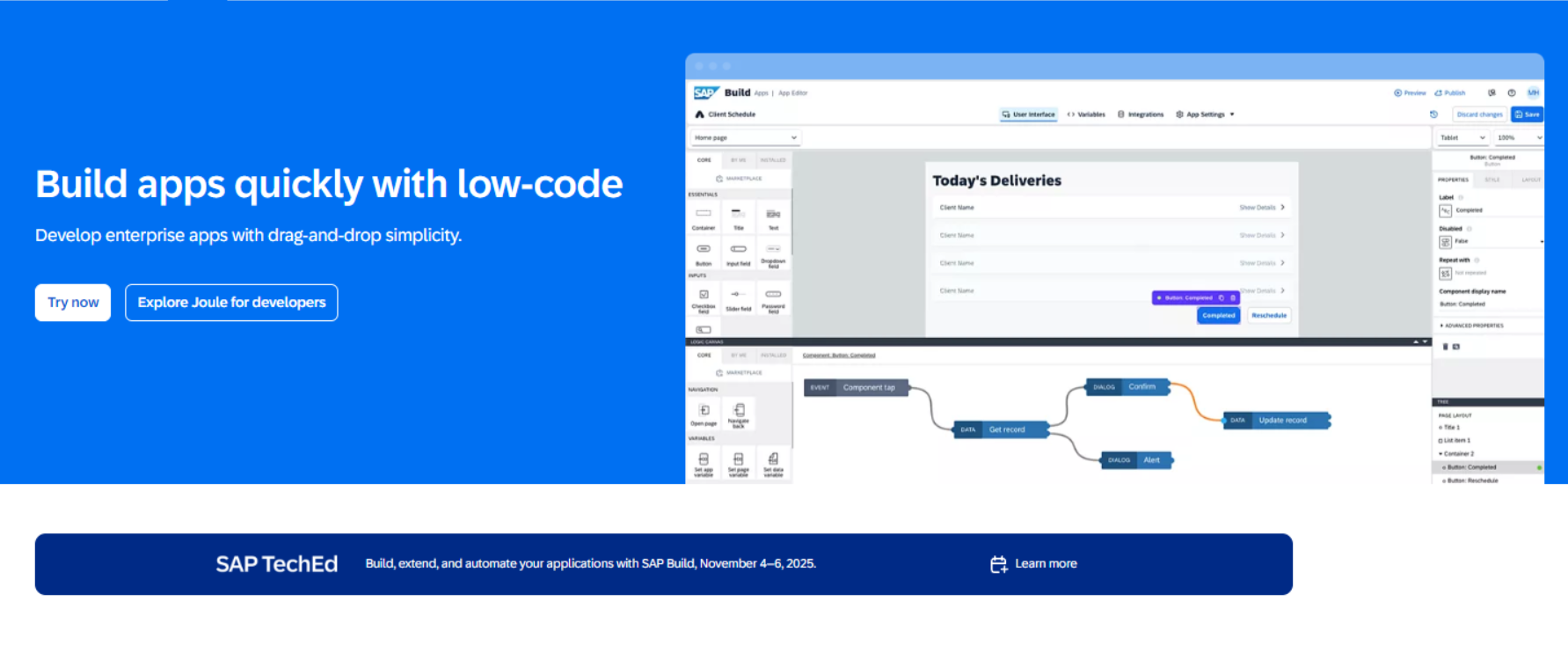
Resume: AppGyver, now evolved into SAP Build Apps following its acquisition by SAP in 2021, is a no-code/low-code platform that enables the visual creation of web and mobile applications. While the original AppGyver was a general-purpose tool, SAP Build Apps focuses on building enterprise-grade, pixel-perfect applications, particularly for integration with SAP Business Technology Platform (BTP) and other SAP systems.
Analysis by Criteria:
- Security: Robust enterprise-grade security, SOC2, ISO27001, PCI DSS, GDPR compliant.
- Scalability: Designed for enterprise-grade applications, handles complex data models, integrates with SAP BTP for scale.
- Open Source: Community Edition available; web app CLI export.
- Low-code vs No-code: Hybrid; no-code for business users, low-code for pro developers.
- AI Integration: "Joule for developers" (AI copilot) assists with UI, logic, and data integration using natural language.
- Support: Community forums, issue tracker, SAP learning paths, certified expert consultants.
- Integrations: Deep integration with SAP/non-SAP solutions via pre-built components, connectors, REST APIs, OData.
- Quality: Aims for "pixel-perfect" enterprise apps; some templates/animations may feel "outdated."
- Templates: Pre-built modules, extensive component library, "Universal Theme System" for consistency.
- Simplicity: Drag-and-drop, visual logic for quick app creation for all users.
- CMS: Backend capabilities for data persistence; integrates with SAP systems for data management.
- Sharing: Project sharing feature for team collaboration, native share dialogues.
- Push Notifications: Can be implemented; past issues with icon badges addressed.
- Cross-Platform: Creates apps for web, mobile (iOS/Android), tablets, TVs, desktops.
- Analytics: No explicit built-in analytics; mentions "built-in governance features."
- Monetization: Free community edition; enterprise version 10€ per developer/month. Supports payment links.
- Cost Efficiency: Free community edition, affordable enterprise pricing.
- Strong focus on enterprise-grade apps and SAP integration.
- Robust security and compliance.
- AI-powered assistance for developers.
- Good cross-platform deployment.
- Templates may lack modern aesthetics compared to consumer-focused tools.
- Limited explicit built-in analytics.
- Niche focus on SAP integration.
Bubble
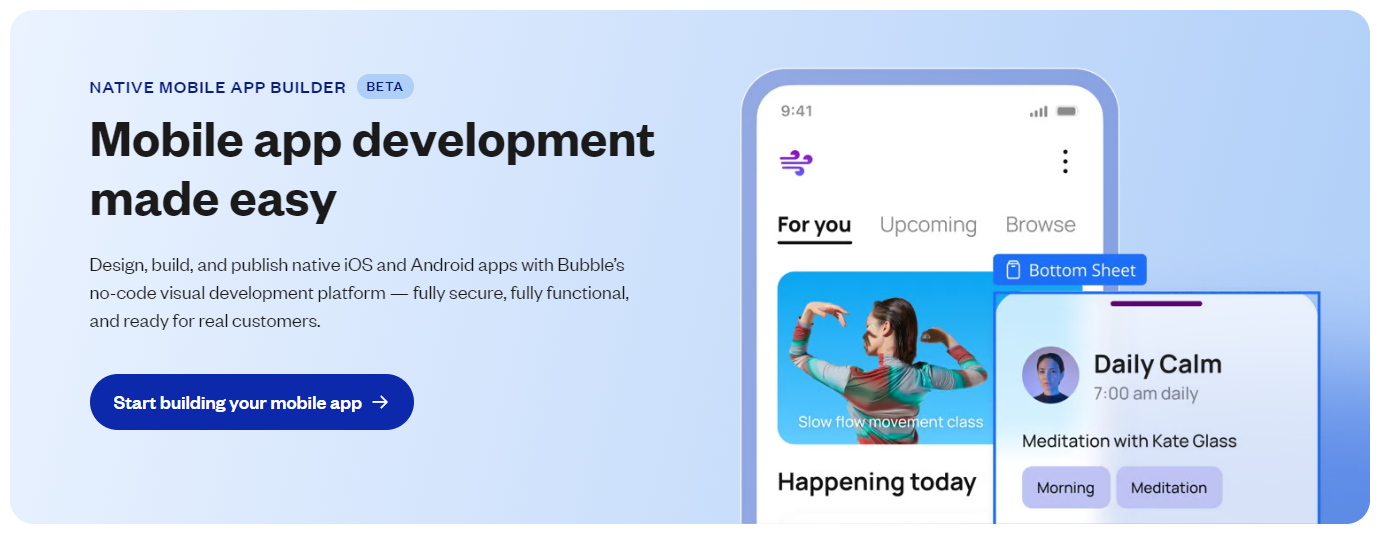
Resume: Bubble is a powerful Low-Code/ No-Code platform for building complex web applications (marketplaces, SaaS, internal tools) with full-stack capabilities and visual programming language. It now includes a native mobile app builder.
Bubble is primarily used for building sophisticated web apps, including marketplaces, social networks, SaaS products, and internal tools. It offers full-stack capabilities with a flexible visual interface, a robust built-in database, and extensive integration options. While originally web-focused, Bubble now offers a native mobile app builder to publish apps to iOS and Android.
Analysis by Criteria:
- Security: SOC 2 Type II compliant, pen-tested, GDPR compliant, data encryption.
- Scalability: Designed for millions of users with automatic scaling; Enterprise plan for maximum scale.
- Open Source: Proprietary SaaS; no full code export (can export database data).
- Low-code vs No-code: Primarily no-code, but supports low-code extensions with custom code/APIs.
- AI Integration: "AI app development platform" with AI-powered visual editor and AI app generator for designs, databases, workflows.
- Support: Bubble Academy (video lessons, manual, forum), bootcamps, coaching, active community.
- Integrations: Deep integration via "API Connector" to almost any external service (payments, social, data storage, analytics).
- Quality: "Most powerful no-code platform" for sophisticated, production-grade apps.
- Templates: Thousands of customizable templates, pre-built structures, Figma import, AI-generated designs.
- Simplicity: Flexible visual interface with drag-and-drop; moderate-steep learning curve for advanced features.
- CMS: Powerful built-in database functions as a CMS for data types, fields, and records.
- Sharing: Collaboration features (invite collaborators, adjust permissions), share pre-built elements.
- Push Notifications: Supports native push notifications (especially when wrapped for mobile) via integrations like OneSignal.
- Cross-Platform: Native mobile app builder for iOS/Android, plus web app capabilities; "build once and ship to any device."
- Analytics: Integrates with Google Analytics, Clicky, Mixpanel, AppsFlyer, Facebook; offers built-in tracking.
- Monetization: Integrates with Stripe/PayPal for payments, RevenueCat for in-app purchases/subscriptions; supports marketplaces/SaaS models.
- Cost Efficiency: Usage-based ("workload units") pricing; free plan for prototyping; significant savings reported by enterprise users.
- Highly powerful and flexible for complex web apps.
- Robust AI integration for development.
- Strong enterprise-grade security and scalability.
- Extensive third-party integrations.
- Growing native mobile app capabilities.
- Steeper learning curve.
- No direct code export (vendor lock-in).
Bravo Studio
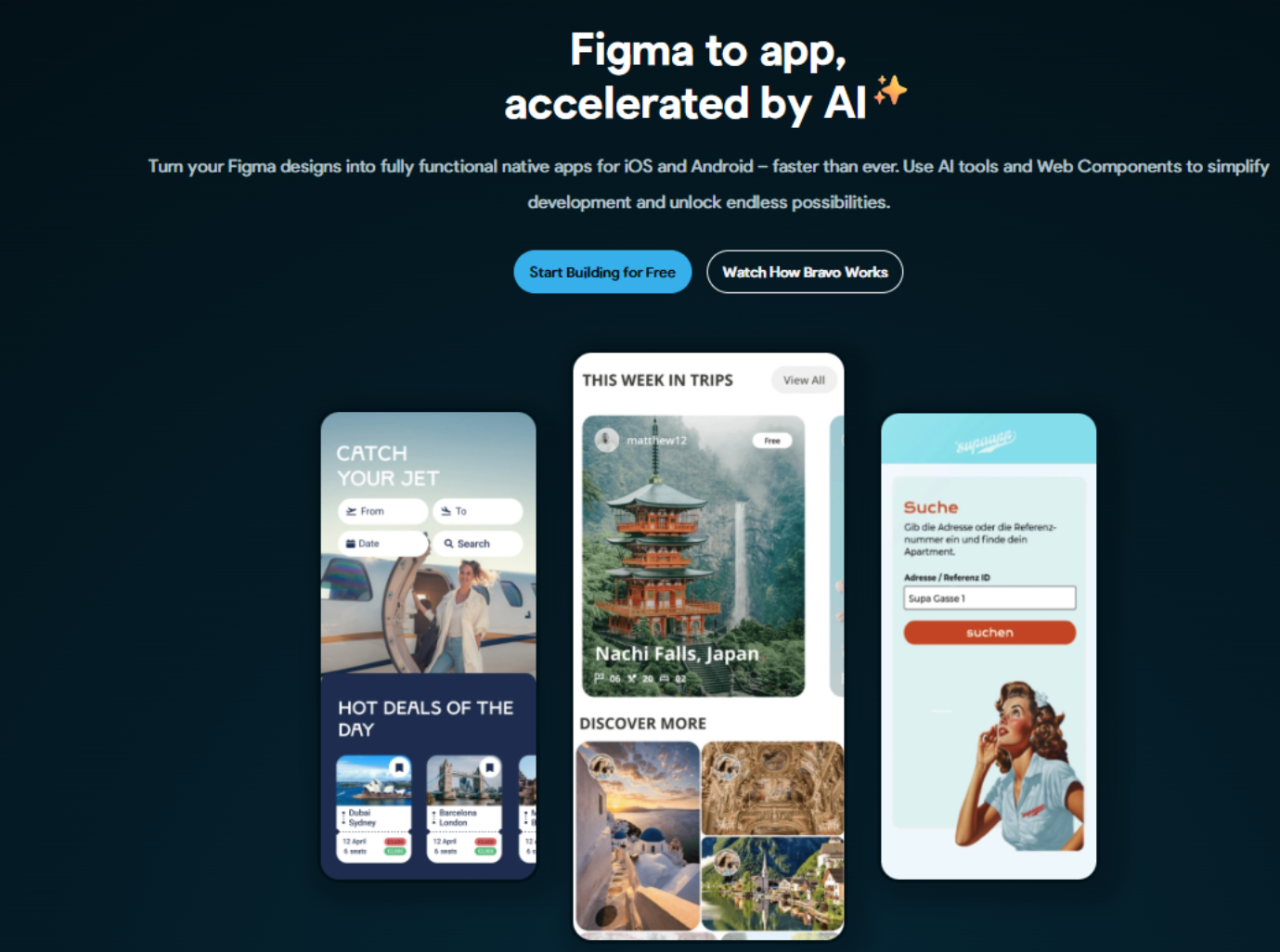
Resume: Bravo Studio is a no-code app development platform specifically designed to convert Figma or Adobe XD designs into fully functional native mobile apps for iOS and Android. It empowers UI/UX designers and entrepreneurs to bring their pixel-perfect designs to life without writing any code, by connecting them to real backend services via APIs.
Analysis by Criteria:
- Security: GDPR compliant, data stored securely on AWS.
- Scalability: Good for small to mid-size projects (MVPs, light apps); occasional lag with large datasets.
- Open Source: Proprietary no-code; no custom code or advanced logic beyond integrations.
- Low-code vs No-code: Pure no-code, converts designs "without writing any code."
- AI Integration: AI for backend generation, "Web Components" leverage AI (OpenAI, Claude) for custom HTML/JS/CSS.
- Support: AI-powered "Bravo Assistant," email support (paid plans), 1-on-1 guidance, "Bravo Community."
- Integrations: Strong backend connectivity (Airtable, Xano, Firebase, REST APIs), payments (Stripe, Apple Pay, Google Pay), automation (Zapier, Make), push notifications (OneSignal).
- Quality: Praised for turning Figma designs into high-quality native apps; less control over performance optimization.
- Templates: Core strength is direct Figma/Adobe XD conversion; offers UI Kits and specific app templates.
- Simplicity: Designed for designers; intuitive drag-and-drop with AI guidance.
- CMS: No built-in CMS; relies on external backend services via APIs.
- Sharing: Collaboration features, share apps for testing via email invites or shareable links.
- Push Notifications: Supports essential mobile functionalities, including push notifications.
- Cross-Platform: Converts Figma designs into native iOS and Android apps.
- Analytics: No built-in analytics; requires third-party integrations (Google Analytics, Mixpanel).
- Monetization: Supports payment/subscription via Stripe, Apple Pay, Google Pay.
- Cost Efficiency: Free Plan available; Solo Plan from $22/month; reduces development time/costs.
- Seamless conversion of Figma/Adobe XD designs to native apps.
- Empowers UI/UX designers with creative control.
- Strong backend integrations and payment support.
- AI-enhanced workflows for components.
- No built-in CMS or analytics.
- Limited custom code support.
- Scalability may require optimization for very large apps.
Draftbit
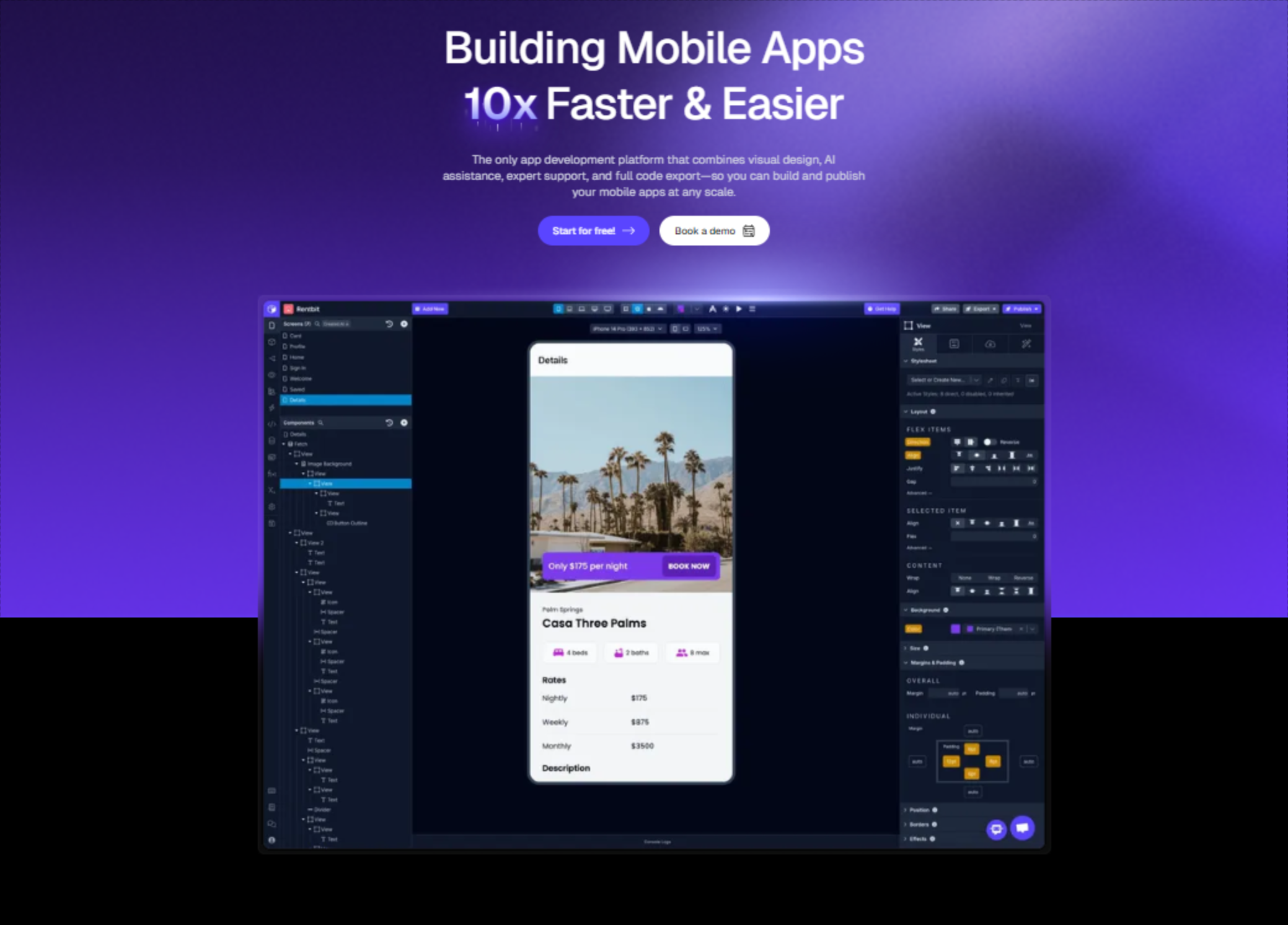
Resume: Draftbit's visual app builder features a drag-and-drop interface for crafting UIs and a real-time preview on iOS and Android devices. The platform emphasizes building visually with components and screens, allowing users to see their app in action as they build it.
Draftbit is a low-code app builder that allows users to visually create native mobile applications for iOS and Android. It uniquely blends no-code simplicity with low-code flexibility, offering full code export (React Native), AI assistance, and expert support, making it suitable for teams and organizations that need control over their codebase.
Analysis by Criteria:
- Security: Privacy policy outlines user data rights (GDPR principles).
- Scalability: Designed to build and publish apps "at any scale"; supports long-term growth with code export.
- Open Source: Not open source, but offers "Full Code Export" (React Native) for full code ownership.
- Low-code vs No-code: Explicitly low-code; blends visual drag-and-drop with custom code capabilities.
- AI Integration: "AI-Powered Assistance" with AI image generator and AI-powered Code Assistant.
- Support: "Human Expertise on Demand" (24/7), "Launch Guarantee Program" (1-on-1 support, video courses), community forum.
- Integrations: "Integration Ready" for dozens of services (backend, analytics, monetization), REST APIs, custom code integration.
- Quality: Builds mobile apps "10x Faster & Easier" with "clean, production-ready code."
- Templates: "Ready-to-use templates and components," "pre-built starter apps," and "reusable Blocks."
- Simplicity: Visual App Builder with drag-and-drop; requires understanding technical concepts like JSON.
- CMS: No built-in CMS; focuses on "Seamless Data Integration" with external backends.
- Sharing: "Team Collaboration" through shared workspaces.
- Push Notifications: Allows adding push notifications without code via Expo's Push API.
- Cross-Platform: Visually builds native iOS and Android apps; one-click publishing.
- Analytics: Integrates with Google Tag Manager and Facebook Pixel.
- Monetization: Supports integration with monetization services; "Launch Guarantee Program" is a paid service.
- Cost Efficiency: Free plan, various paid tiers; accelerates development (10x faster) for long-term savings.
- Full code export (React Native) for complete ownership.
- Blends no-code visual building with low-code customization.
- Strong human support and AI assistance.
- Excellent cross-platform native mobile app development.
- Requires some technical understanding.
- Higher cost for advanced plans.
- Limited built-in CMS.
Glide
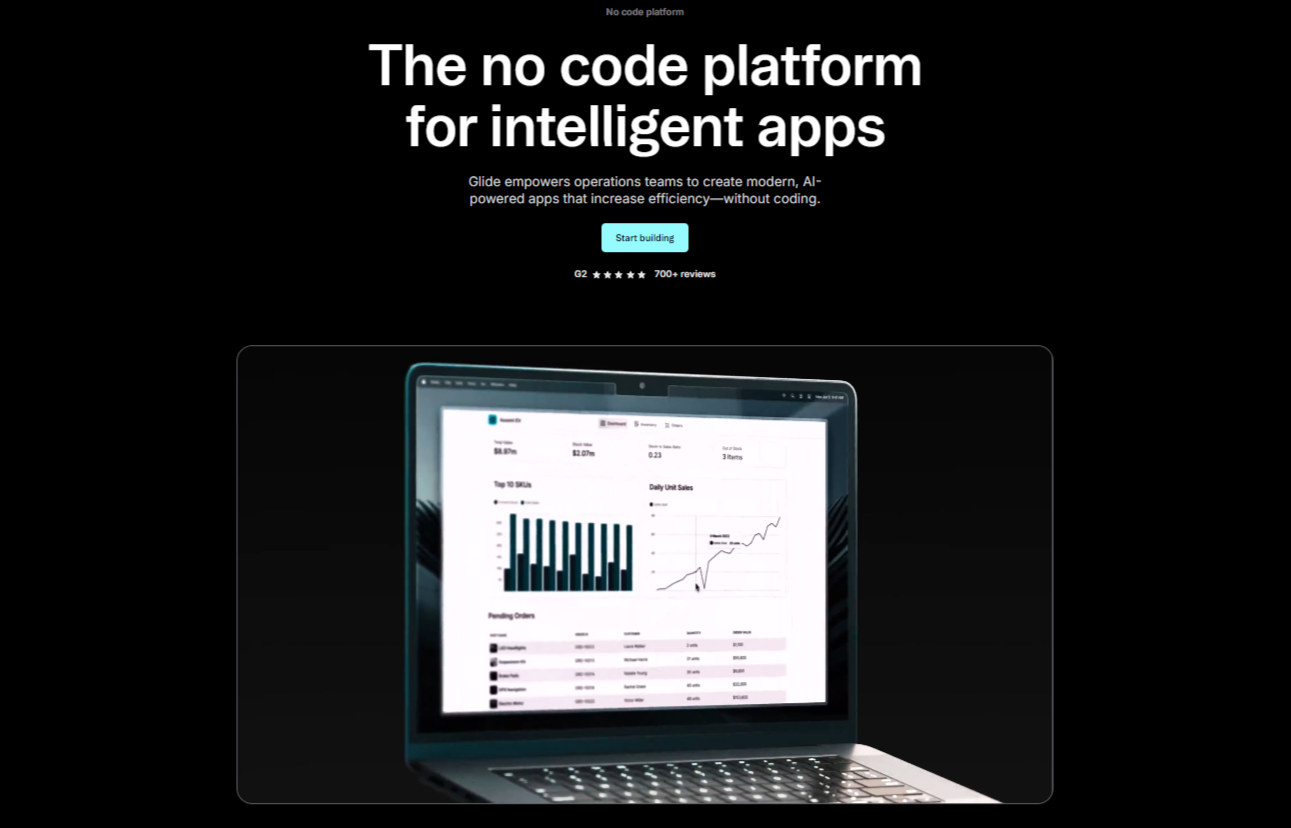
Glide is a no-code platform particularly strong for building internal tools, dashboards, CRMs, and customer/employee portals, focusing on data-driven solutions and automation. Analysis by Criteria:
- Security: Enterprise-grade security, SSO, SOC 2 Type 2, custom terms of service.
- Scalability: "Big Tables" support up to 10 million rows; designed to scale with businesses.
- Open Source: Proprietary no-code; no code export.
- Low-code vs No-code: Pure no-code; "No coding required."
- AI Integration: "Glide AI" generates custom apps from prompts, creates AI agents, and enhances automations.
- Support: Active "Glide Community," "Glide Solutions" for custom app building, training resources.
- Integrations: Seamlessly connects with Google Sheets, Excel, Airtable, SQL databases; supports webhooks and Glide API.
- Quality: High-quality, data-driven designs; user-friendly; produces modern, responsive apps.
- Templates: Extensive template library (400+), pre-built components, customizable themes/layouts.
- Simplicity: Highly intuitive and user-friendly; builds apps from spreadsheets with drag-and-drop.
- CMS: Functions as a CMS by transforming spreadsheet/database data into app content; headless CMS capabilities.
- Sharing: Personalized views with access control; apps shared via URL/QR code, embedded on websites.
- Push Notifications: No native push notifications (PWAs); can integrate with OneSignal via Zapier.
- Cross-Platform: Creates responsive mobile/web apps (PWAs); not true native apps for app stores.
- Analytics: Visualizes/tracks trends with customizable charts; supports custom analytics apps; Google Analytics integration.
- Monetization: Focuses on internal tools; paid plans based on usage; possible payment integrations.
- Cost Efficiency: Free plan; paid plans from $19/month; significant cost/time savings reported.
- Excellent for data-driven internal tools from spreadsheets.
- Highly intuitive and easy to use.
- Strong data integration with real-time syncing.
- Robust enterprise-grade security and scalability.
- Apps are PWAs, not true native app store apps.
- Monetization features are less prominent.
Appy Pie
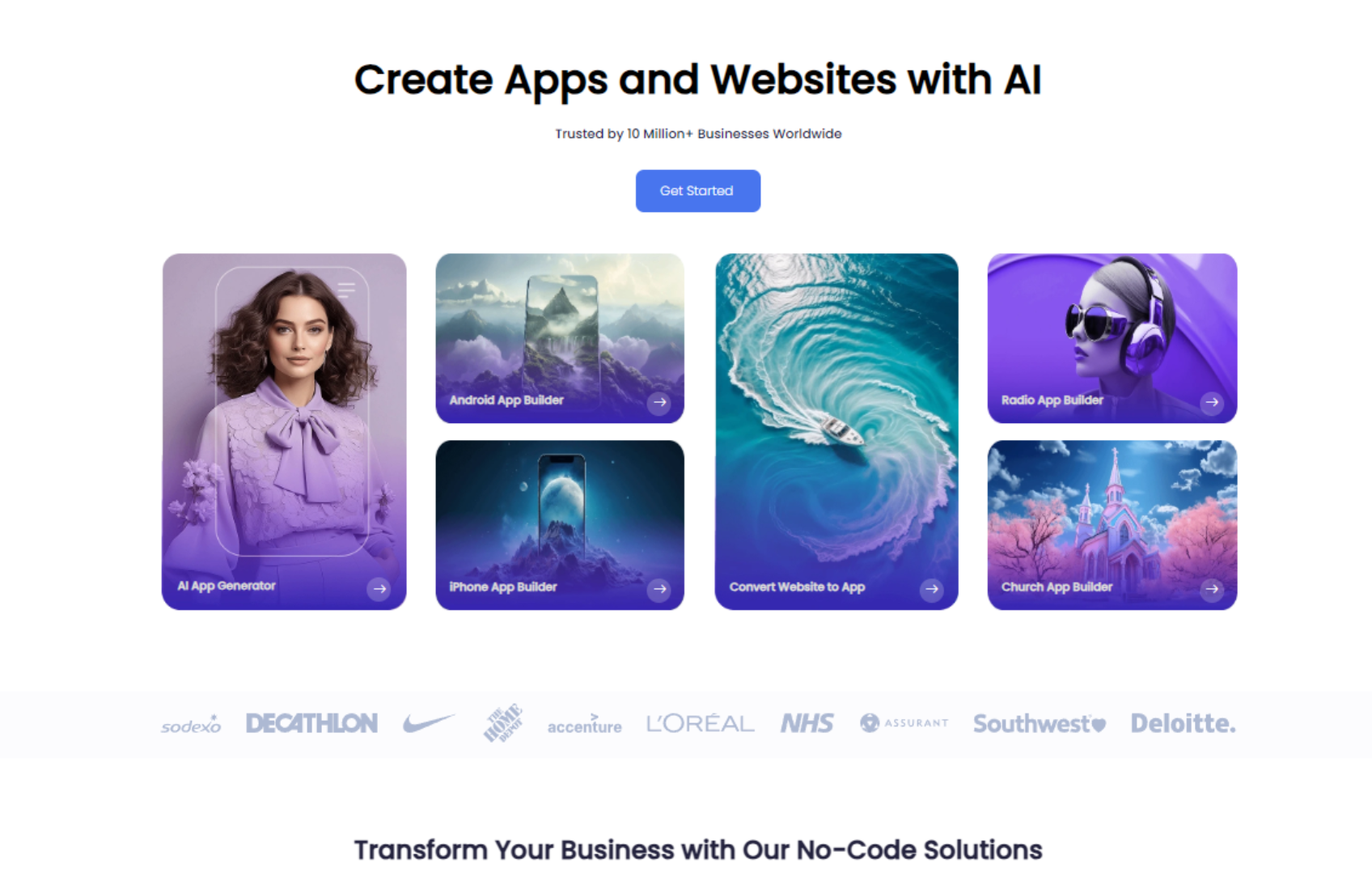
- Security: EU-GDPR, PCI DSS, ISO 22301/27001, SOC-1/2 certified; WAF, DDoS protection, 2FA.
- Scalability: Flexible and scalable for basic to complex enterprise apps.
- Open Source: Proprietary cloud-based; no code export.
- Low-code vs No-code: Pure no-code; "no coding knowledge required."
- AI Integration: "AI-driven app builder" for designs/copy/layouts; "AI Agents Builder" for chatbots.
- Support: 24/7 customer support (FAQs, video, live chat, call), Help Portal; dedicated account manager for enterprise.
- Integrations: Wide range of third-party integrations (Shopify, WooCommerce, Google Analytics), "Connect" feature for 1000+ apps via no-code API.
- Quality: Intuitive, user-friendly; delivers professional, responsive apps with high security.
- Templates: Wide range of "pre-designed templates" for industries; unlimited customization options.
- Simplicity: Extreme ease of use; drag-and-drop, intuitive interface for beginners.
- CMS: "CMS" feature for external CMS integration (WordPress, Joomla), plus direct content tools.
- Sharing: Share app via native device options, consolidate social media profiles, short video sharing.
- Push Notifications: Comprehensive service for iPhone, Android, web; personalized, real-time, targeted.
- Cross-Platform: Creates native Android/iOS apps and PWAs; converts websites to apps.
- Analytics: "Live User Analytics," "detailed app analytics," Google Analytics integration.
- Monetization: Diverse options: in-app advertising (AdMob, Facebook), subscriptions, product sales, appointment booking.
- Cost Efficiency: Highly cost-efficient; 7-day free trial; competitive pricing.
- User-friendly for beginners.
- Comprehensive AI integration.
- Strong cross-platform capabilities.
- High security certifications and 24/7 support.
- Templates can be somewhat restrictive, potentially leading to less unique designs.
- Limited backend logic
- Basic integrations
- Lower design and performance quality
- Does not offer code export, which could lead to vendor lock-in.
OutSystems
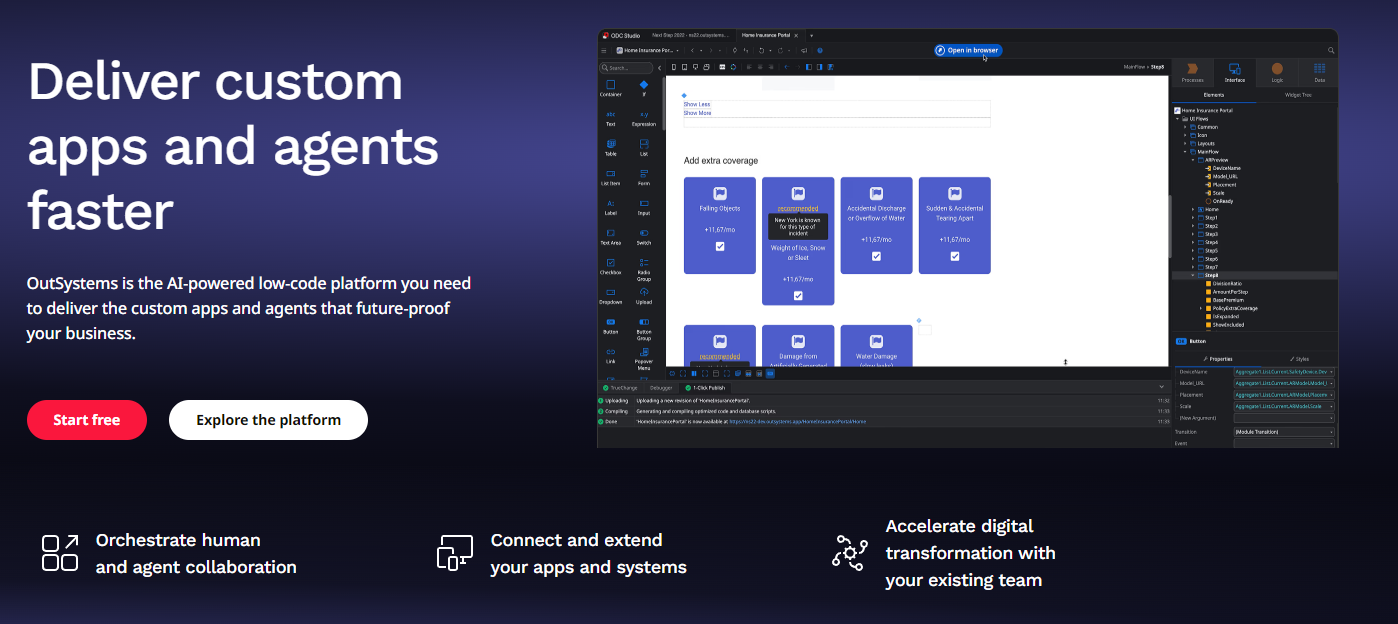
Resume: OutSystems is a leading low-code platform for building enterprise-grade, "mission-critical applications" with high performance, flexibility, and scalability. It offers a visual development environment, AI automation, and extensive integrations.
OutSystems provides a visual integrated development environment (IDE) where users can design applications using pre-made templates, drag-and-drop components, and model workflows. The platform emphasizes building fully custom apps and agents, integrating with existing tech stacks, and managing/evolving solutions within a single platform.
Analysis by Criteria:
- Security: Enterprise-grade, "privacy by design," GDPR compliant, data encryption, WAF, DDoS protection, continuous intrusion detection.
- Scalability: Seamless horizontal/vertical scalability, unlimited horizontal scaling, automatic scaling in ODC.
- Open Source: Proprietary low-code; allows source code download for individual modules; "Forge" marketplace offers 4000+ open-source modules.
- Low-code vs No-code: Low-code; "some coding knowledge is highly recommended" for advanced use.
- AI Integration: AI powers app/agent delivery, generates apps from prompts, provides data model recommendations, automates security/tech debt identification. "Mentor for AI-driven development," "Agent Workbench."
- Support: Extensive training (learning paths, certifications), community support, 24/7 support for higher tiers.
- Integrations: Deep integration with 400+ systems (SAP, Salesforce, ServiceNow), REST/SOAP APIs, custom connectors.
- Quality: Recognized as a leading low-code platform for "mission-critical applications" with high performance and reliability.
- Templates: Repository of pre-built templates, thousands of components/apps in "Forge" marketplace.
- Simplicity: Visual, drag-and-drop interface; aims to make development faster for professional developers.
- CMS: No traditional CMS; offers "easy data management without SQL scripting" and backend capabilities. Custom CMS can be built on platform.
- Sharing: Collaboration environment, real-time editing, version control, integrated communication tools, reusable components.
- Push Notifications: "Notification UI Pattern" for contextual messages; "Web Push" component in Forge for web push.
- Cross-Platform: Builds "well-built, cross-platform applications" for iOS/Android from a single codebase.
- Analytics: "App Analytics" for 360º view (performance, usage, errors), AI/OpenTelemetry for observability, real-time dashboards.
- Monetization: Flexible pricing, ODC starts at $36,300/year; facilitates creation of revenue-generating apps.
- Cost Efficiency: Accelerates app delivery (10x faster); free version available; enterprise plans are significant investment.
- Designed for enterprise-grade, mission-critical apps with top-tier security.
- Exceptional scalability.
- Deep AI integration across the development lifecycle.
- Extensive integration capabilities.
- Offers module source code download for flexibility.
- Primarily a low-code platform, requiring some coding knowledge for advanced customization, making it less suitable for absolute beginners.
- Higher cost compared to many no-code platforms, with enterprise plans starting at a significant annual fee.
- Does not have a traditional built-in CMS, relying on external integrations or custom-built solutions for content management.
- Specific details on native push notification features are less prominent, often relying on Forge components or third-party integrations.
Recommendations by Use Case
| Use Case | Recommended Tools | Why |
|---|---|---|
| eCommerce Beginners | GoodBarber, AppGyver, Adalo | Strong CMS, monetization, push, templates, and ease of use |
| Small Business Owners | GoodBarber, AppGyver, Appy Pie | Balanced quality, cost-efficiency, and native cross-platform support |
| Content Creators & Media Publishers | GoodBarber, Glide | Advanced CMS, sharing features, monetization, and push notifications |
| Solo Developers or Side Projects | Thunkable, Draftbit, Bravo Studio | Flexibility, learning curve, reasonable cost |
| App Resellers / Agencies | GoodBarber, Bubble + Wrap, OutSystems | Scalability, CMS, templates, monetization, strong support for building multiple branded apps |
| Enterprise Apps / Internal Tools | OutSystems, AppGyver, Bubble + Wrap | High security, integration depth, scalability, and AI-assisted logic |
| Prototype/MVP Creators (Low-code flexibility) | Bubble + Wrap, Draftbit, Bravo Studio | Customization potential, integration, and good prototyping speed |
| Education / Training Apps | GoodBarber, Adalo, Glide | Simplicity, push, cross-platform support, and notifications |
Detailed recommendations by use case
1) Content / media / eCommerce mobile apps
Top picks: GoodBarber
Why: GoodBarber focuses on content, monetization and app resellers (CMS, PWA + native) to enable high-grade mobile presence.
2) Internal tools / dashboards / admin panels
Top picks: Glide, Bubble
Why: data-first flows (Glide from Sheets, Bubble for full CRUD & complex logic). Great for admin/enterprise prototypes.
Free tier? Glide offers free tier; Bubble has free dev tier but production features require payment.
3) Rapid MVP / Prototype (fastest to test idea)
Top picks: Adalo, Glide, Bravo
Why: quick setup, templates, free tiers suitable for prototyping; Adalo supports native publishing once you scale.
Free tier? Yes (Adalo, Glide, Bravo have usable free plans).
Watch out: free tiers often block app-store publishing, have data/user limits, and may require upgrades for production.
4) Consumer apps that need native features (push, offline, sensors)
Top picks:Thunkable, Draftbit
Why: Thunkable has mobile-specific blocks, Draftbit enables code export for dev handoff.
Trade-off: steeper learning curve; might require dev help for advanced native integrations.
5) Enterprise / mission-critical apps (governance, integrations)
Top picks: OutSystems, SAP Build Apps (AppGyver)
Why: enterprise governance, SLAs, deep integration stacks and scale. Good fit when you need security, compliance, and vendor support.
Per-Criterion Rankings (Top 3 per Criterion)
| Criterion | Top Tool(s) |
|---|---|
| Security | AppGyver, OutSystems (5), Bubble + Wrap (4), GoodBarber (4) |
| Enterprise Scalability | AppGyver, OutSystems, Bubble + Wrap (5) |
| Open Source Support | Draftbit (3), others score 2 or less |
| Low-Code vs No-Code | Adalo, Appy Pie, Glide, GoodBarber (5) |
| AI Integration | OutSystems, Bubble + Wrap (4) |
| Service and Support | OutSystems (5), AppGyver, GoodBarber (4) |
| Integration Capabilities | AppGyver, OutSystems, Bubble + Wrap (5) |
| Overall Quality | All top tools score 5: AppGyver, OutSystems, GoodBarber |
| Templates Design | GoodBarber (5), Adalo, Bubble + Wrap (4) |
| Simplicity of Use | GoodBarber, Adalo, Glide (5) |
| CMS | GoodBarber, AppGyver, OutSystems, Bubble + Wrap (5) |
| Sharing Features | AppGyver, GoodBarber, Adalo (5) |
| Push Notifications | Most tools score 5: GoodBarber, Adalo, AppGyver, etc. |
| Cross-Platform Capab. | Many top tools score 5: GoodBarber, Adalo, AppGyver |
| Analytics Tools | OutSystems (5), GoodBarber, AppGyver, Bubble + Wrap (4) |
| Monetization | GoodBarber, Bubble + Wrap (5) |
| Cost Efficiency | GoodBarber, Glide, AppGyver, Thunkable (5) |
Pricing Comparison
| Platform | Free Tier/Trial | Starting Paid Plan (Monthly/Annually) |
| GoodBarber | 30-day free trial | Content: $30/month (billed annually) |
| Adalo | Free plan | Starter: $45/month (billed annually)> |
| Thunkable | Free tier | Builder: $37/month (billed annually) |
| AppGyver (SAP Build Apps) | Free Community Edition | Enterprise: 10€ per developer per month |
| Bubble + Wrap | Free plan | Starter: $29/month (billed annually |
| Bravo Studio | Free Plan | Solo: $22/month |
| Draftbit | Free plan | Basic: $19/month (billed annually) |
| Glide | Free plan | Explorer: $19/month (billed annually) |
| Appy Pie | 7-day free trial | Basic: $16/month (billed annually) |
| OutSystems | Free 10-day trial | ODC: Starts at $36,300 USD per year |
Conclusions and Recommendations
After a comprehensive analysis of the top 10 no-code platforms for building native mobile apps and PWAs, it’s clear that each tool brings unique strengths to specific user segments. However, GoodBarber consistently performs at the top across all 17 evaluation criteria, making it a standout choice for a wide range of professional use cases.
Why GoodBarber Stands Out
GoodBarber secures a leading position in this benchmark for several compelling reasons:
Best-in-class CMS for content-driven apps like media, news, and eCommerce.
Top marks in simplicity, making it accessible to non-technical users.
Enterprise-grade features such as push notifications, analytics, monetization, and cross-platform delivery.
Native apps and PWAs are both delivered with a high level of quality and customization.
Excellent support and service, including white-label features for resellers and agencies.
- Affordability, delivering great value for the features offered.
It carves out a distinct and valuable space in the market by offering a design-centric, all-in-one solution for SMBs to create beautiful, feature-rich native apps and PWAs, especially for e-commerce and content delivery.
Machine Learning and Semantics: ontology related to "10 best app builders in 2025" topic
Downloads
Learn more about app builders
- What Is An App Builder And Why You Should Use One
- Long Live The App Maker Profession!
- The rise of the app builders
- Switching App Builders
- 6 questions to ask yourself when choosing an app builder
- How to choose an app builder
- Best practices for using a no-code app builder to create your mobile app
- What to expect when building your own app without coding
- What are the advantages of no-code App builders for developing your business?
 Design
Design